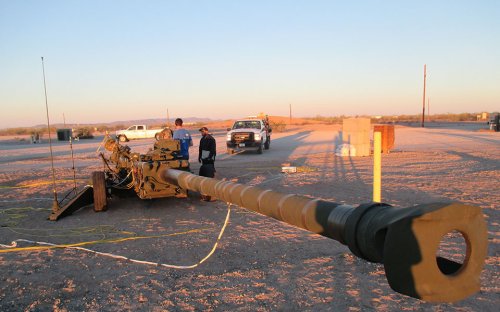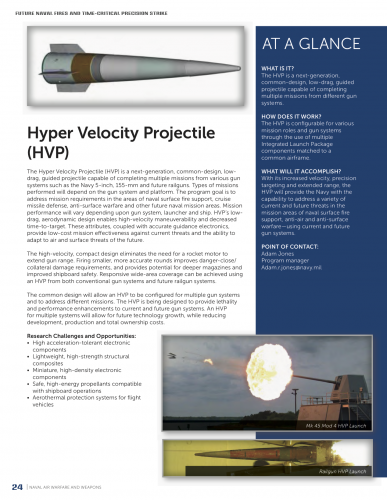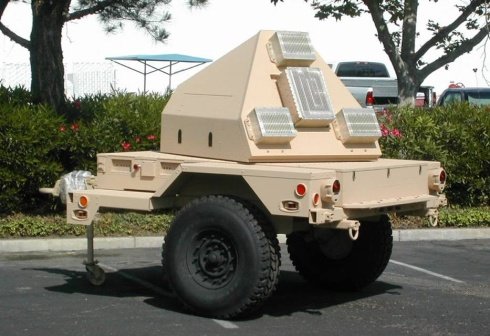bring_it_on
I really should change my personal text
- Joined
- 4 July 2013
- Messages
- 3,233
- Reaction score
- 2,595
SCO aims to flip the script on missile defense for bases, ports, ships with hypervelocity gun
The Pentagon wants to take a weapon originally designed for offense, flip its punch for defense and demonstrate by 2018 the potential for the Army and Navy to conduct missile defense of bases, ports and ships using traditional field guns to fire a new hypervelocity round guided by a mobile, ground variant of an Air Force fighter aircraft radar.
The Strategic Capabilities Office is working with the Army, Navy and Air Force to craft a Hypervelocity Gun Weapon System that aims, in part, to provide China and Russia an example of a secret collection of new U.S. military capabilities the Defense Department is bringing online in an effort to strengthen conventional deterrence.
"It is a fantastic program," Will Roper, Strategic Capabilities Office director, said in a March 28 interview with reporters, who said the project aims "to completely lower the cost of doing missile defense" by defeating missile raids at a lower cost per round and, as a consequence, imposing higher costs on attackers.
Current U.S. missile defense capabilities are centered around very sophisticated guided-missile interceptors, which cost -- in most cases -- millions of dollars per shot, an approach the Army and Navy service chiefs, in a Nov. 5, 2014 joint memo, warned the defense secretary is "unsustainable."
"Projectiles that we fire and test today are on the order of $50,000 currently and we hope to push down to $35,000 -- a two order-of-magnitude swing in some cases," Roper said.
The Pentagon is seeking $246 million for the HGWS in fiscal year 2017, building on $364 million appropriated for the project in FY-15 and FY-16.
The HGWS takes smart projectiles developed for the Navy's electromagnetic railgun and fires them with artillery already in the inventory.
"Cost-effective, large magazine, base defense will be demonstrated by closing the fire-control loop between existing sensors and prototype projectiles launched from existing powder guns including the Navy's Mk-45 5-inch Naval gun and the Army's Paladin 155 mm self-propelled howitzer; advanced powder gun prototypes; and the electromagnetic railgun," the Pentagon's FY-17 budget request states.
The Army and Navy have a combined inventory of approximately 1,000 guns capable of firing rounds of this size, including about 900 Army Paladins. The Navy has about 100 cruisers and destroyers, each with one 5-inch MK-45 gun on the bow.
"The intended end-state is a prototype system that retires risks to allow transition of gun-based defense to partners: the Missile Defense Agency, the Navy, and/or the Army," the budget request adds.
Roper, during the March 28 interview, disclosed a new dimension of the HGWS project.
"We haven't talked publicly about the sensor that we're doing with that," he said. "So, if you're going to do missile defense, you're going to need something to do the tracking. And we are working very extensively with taking fighter radars, in which we have a huge investment, and building ground-based variants of these."
The SCO is working to fashion a ground variant of the most advanced fighter radars, based on active electronically scanned array (AESA) technology: "Putting them on the ground to support intercepts of systems that can truly move," Roper said, referring to the radar's role in plans to take out ballistic and cruise missile threats.
He said the hypervelocity project has evolved to be a joint effort with three services: "We have a Navy round, an Army gun, and an Air Force sensor -- all combined into one Frankenstein architecture."
Roper, who was the Missile Defense Agency's director for engineering before being tapped to head the SCO at its formation in August 2012, declined to quantify the estimated range for the hypervelocity gun system.
"It goes without saying that because it is a gun, it is not a huge area defense," Roper said. "We're wanting to be able to defend high-value, small-area assets -- forward operating bases, ships, ports with a high, high density of fire -- with assets that are completely mobile."
He noted that much of the existing missile-defense capability is hindered by being fixed infrastructure. "Things that don't move give an opponent a decided advantage," Roper said. "We want to deny those, complicate their counter-targeting" with the HGWS, he said.
"We'd like opponents of the U.S. to think: 'I can't saturate their defense by having enough systems on my side.' We'd like them to think these critical forward operating bases and stations will continue to operate no matter how many missiles they continue to throw at them," the SCO director said. "We want that deterrent aspect in play."
Roper said the SCO is testing the new round out of the guns every three months. "We hope to prove the end-to-end architecture by the end of 2018," he said.
The Pentagon wants to take a weapon originally designed for offense, flip its punch for defense and demonstrate by 2018 the potential for the Army and Navy to conduct missile defense of bases, ports and ships using traditional field guns to fire a new hypervelocity round guided by a mobile, ground variant of an Air Force fighter aircraft radar.
The Strategic Capabilities Office is working with the Army, Navy and Air Force to craft a Hypervelocity Gun Weapon System that aims, in part, to provide China and Russia an example of a secret collection of new U.S. military capabilities the Defense Department is bringing online in an effort to strengthen conventional deterrence.
"It is a fantastic program," Will Roper, Strategic Capabilities Office director, said in a March 28 interview with reporters, who said the project aims "to completely lower the cost of doing missile defense" by defeating missile raids at a lower cost per round and, as a consequence, imposing higher costs on attackers.
Current U.S. missile defense capabilities are centered around very sophisticated guided-missile interceptors, which cost -- in most cases -- millions of dollars per shot, an approach the Army and Navy service chiefs, in a Nov. 5, 2014 joint memo, warned the defense secretary is "unsustainable."
"Projectiles that we fire and test today are on the order of $50,000 currently and we hope to push down to $35,000 -- a two order-of-magnitude swing in some cases," Roper said.
The Pentagon is seeking $246 million for the HGWS in fiscal year 2017, building on $364 million appropriated for the project in FY-15 and FY-16.
The HGWS takes smart projectiles developed for the Navy's electromagnetic railgun and fires them with artillery already in the inventory.
"Cost-effective, large magazine, base defense will be demonstrated by closing the fire-control loop between existing sensors and prototype projectiles launched from existing powder guns including the Navy's Mk-45 5-inch Naval gun and the Army's Paladin 155 mm self-propelled howitzer; advanced powder gun prototypes; and the electromagnetic railgun," the Pentagon's FY-17 budget request states.
The Army and Navy have a combined inventory of approximately 1,000 guns capable of firing rounds of this size, including about 900 Army Paladins. The Navy has about 100 cruisers and destroyers, each with one 5-inch MK-45 gun on the bow.
"The intended end-state is a prototype system that retires risks to allow transition of gun-based defense to partners: the Missile Defense Agency, the Navy, and/or the Army," the budget request adds.
Roper, during the March 28 interview, disclosed a new dimension of the HGWS project.
"We haven't talked publicly about the sensor that we're doing with that," he said. "So, if you're going to do missile defense, you're going to need something to do the tracking. And we are working very extensively with taking fighter radars, in which we have a huge investment, and building ground-based variants of these."
The SCO is working to fashion a ground variant of the most advanced fighter radars, based on active electronically scanned array (AESA) technology: "Putting them on the ground to support intercepts of systems that can truly move," Roper said, referring to the radar's role in plans to take out ballistic and cruise missile threats.
He said the hypervelocity project has evolved to be a joint effort with three services: "We have a Navy round, an Army gun, and an Air Force sensor -- all combined into one Frankenstein architecture."
Roper, who was the Missile Defense Agency's director for engineering before being tapped to head the SCO at its formation in August 2012, declined to quantify the estimated range for the hypervelocity gun system.
"It goes without saying that because it is a gun, it is not a huge area defense," Roper said. "We're wanting to be able to defend high-value, small-area assets -- forward operating bases, ships, ports with a high, high density of fire -- with assets that are completely mobile."
He noted that much of the existing missile-defense capability is hindered by being fixed infrastructure. "Things that don't move give an opponent a decided advantage," Roper said. "We want to deny those, complicate their counter-targeting" with the HGWS, he said.
"We'd like opponents of the U.S. to think: 'I can't saturate their defense by having enough systems on my side.' We'd like them to think these critical forward operating bases and stations will continue to operate no matter how many missiles they continue to throw at them," the SCO director said. "We want that deterrent aspect in play."
Roper said the SCO is testing the new round out of the guns every three months. "We hope to prove the end-to-end architecture by the end of 2018," he said.



